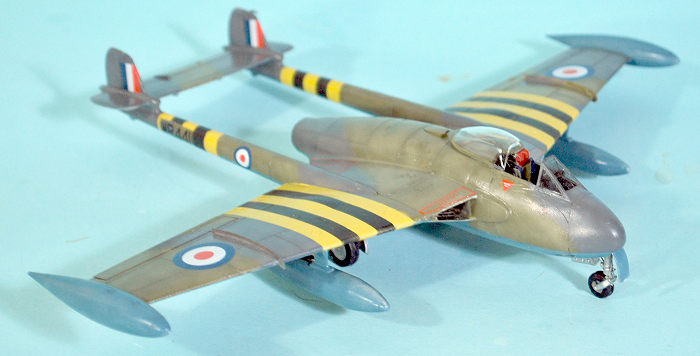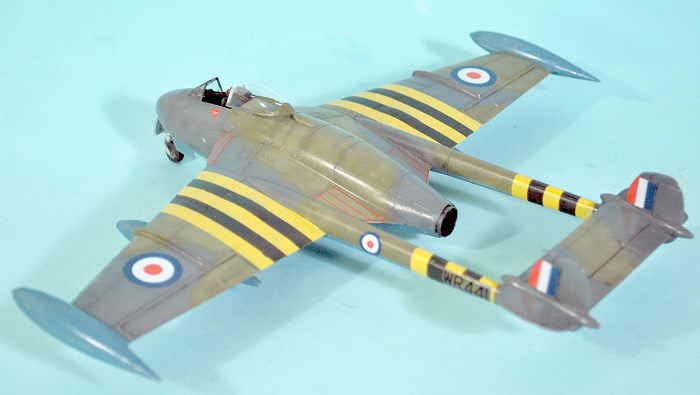
Mikro-Mir 1/48 Venom FB.4
| KIT #: | 48-020 |
| PRICE: | $55.00 |
| DECALS: | Two options |
| REVIEWER: | Tom Cleaver |
| NOTES: | Short run kit. |

| HISTORY |
De Havilland proposed a development of the Vampire for the high altitude fighter-bomber role in 1948, using a thinner wing and a more powerful engine. With the4 company identification of DH 112, further development to fulfill Air Ministry requirement OR.277, defined in Specification F.15/49, for a fast, maneuverable fighter -bomber to replace the Vampire in that role.
 While generally
similar in layout to the preceding Vampire, sharing the distinctive twin-boom
tail and composite wood/metal structure, the Venom was a completely new design,
powered by the de Havilland Ghost 103 jet engine with 4,850lb of thrust, 50%
more powerful than the de Havilland Goblin used by the Vampire.
While generally
similar in layout to the preceding Vampire, sharing the distinctive twin-boom
tail and composite wood/metal structure, the Venom was a completely new design,
powered by the de Havilland Ghost 103 jet engine with 4,850lb of thrust, 50%
more powerful than the de Havilland Goblin used by the Vampire.
Both the Royal Air Force and the Royal Navy took interest in the Venom, with the version developed for the RN being a two-seat radar-equipped all-weather fighter, which was also adopted in a non-naval configuration by the RAF to replace the interim Vampire night fighter. The RAF, however, concentrated on the single-seat fighter bomber, the prototype of which first flew on September 2, 1949.
The Venom entered service with the RAF in 1952, in both the single-seat FB 1 fighter-bomber (365 constructed) and two-seat NF 2 night fighter (90 built), which was replaced in 1953 by the NF 3 (129 built). British Venoms saw active combat during their operational life, including the Suez Crisis, the Malayan Emergency, and the Aden Emergency. It was withdrawn from frontline operations by the RAF in 1962. From the beginning, the fighter-bomber was to be given to overseas forces, such as the Second Tactical Air Force in Germany as well as Cyprus, the Middle East, Africa, and Asia.
 The Venom FB 4
first flew on December 29, 1953, and entered service in 1955; 250 were built,
with an improved de Havilland Ghost 105 jet engine rated at 5150lb of thrust.
The FB.4 was first Venom to be fitted with an ejection seat, as well as having
redesigned tail surfaces and hydraulically-powered ailerons, and air
conditioning for the cockpit.
The Venom FB 4
first flew on December 29, 1953, and entered service in 1955; 250 were built,
with an improved de Havilland Ghost 105 jet engine rated at 5150lb of thrust.
The FB.4 was first Venom to be fitted with an ejection seat, as well as having
redesigned tail surfaces and hydraulically-powered ailerons, and air
conditioning for the cockpit.
The Venom was also proved popular on the export market, with the air forces of Iraq, New Zealand, Sweden, Switzerland and Venezuela using Venoms. The Swiss Air Force finally retired their last Venoms in 1983. Several of the Swiss Venoms have been acquired by private owners and several continue to fly, being seen in aerial displays at various air shows, while many have been preserved in static display conditions in museums and as gate guardians.
The Venom FB 4, which had equipped, 6, 8, and 249 squadrons at Akrotiri, Cyprus between March and July 1956, saw combat service during the Suez Crisis during late 1956. The Venoms attacked military installations on the ground; 6 Squadron, which had operated the FB 4 the longest, took the leading role. Only a single RAF Venom FB 4 was lost during the crisis.
| THE KIT |
 Classic
Airframes released a Venom FB 1, FB 4, NF 2 and Sea Venom FAW 21/22 in 2003-04.
These kits now go for over $100 at eBay, though I was able to get a Sea Venom
from the Rare Plane Detective for $35 and would have gotten an FB 4 for the same
price but I was ten minutes late making my phone call.
Classic
Airframes released a Venom FB 1, FB 4, NF 2 and Sea Venom FAW 21/22 in 2003-04.
These kits now go for over $100 at eBay, though I was able to get a Sea Venom
from the Rare Plane Detective for $35 and would have gotten an FB 4 for the same
price but I was ten minutes late making my phone call.
Mikro Mir released their FB 4 last fall. At a price of $55, it is considerably less expensive than a collector-kit Classic Airframes model. Unlike the Classic Airframes kit, all parts are plastic. The kit is based on a contemporary warbird ex-Swiss AF Venom, and as such uses the later, larger underwing tanks developed in Switzerland for their Venoms. Decals are provided for two units - 28 Squadron at Kai Tak in 1963 (I actually saw these airplanes during my first visit to Hong Kong in the Navy that year, just before they left service) and 11 Squadron in 2TAF at Wunsdorf, Germany in 1957.
| CONSTRUCTION |
Mikro-Mir models are limited run kits, and not as high-end as Dor Wings or AMG kits; their parts fit can be problematic and you will always use filler on the kits.
The construction design of the central pod with the cockpit and engine is problematic. I spent quite a bit of time test-fitting parts before I concluded that the sequence in the instruction sheet was not going to cut it.
 I ended up
building the model by basing everything on the lower pod/wing part, and building
up from there. I constructed the engine exhause and the intake trunking, and
attached those to the lower airfame part. I then attached the upper airframe
part, and found there was a need for C-A glue to get hold the assembly in
position so that the interior parts fit to the exterior parts. I also assembled
and attached the booms and the tail assembly
I ended up
building the model by basing everything on the lower pod/wing part, and building
up from there. I constructed the engine exhause and the intake trunking, and
attached those to the lower airfame part. I then attached the upper airframe
part, and found there was a need for C-A glue to get hold the assembly in
position so that the interior parts fit to the exterior parts. I also assembled
and attached the booms and the tail assembly
I then assembled the cockpit and attached it, then the outer nose parts around the cockpit, after stuffing squashed fishweights everywhere I could; with the airframe mostly assembled, I was able to confirm the model would nose sit. I sued the Eduard photo-etch instrument panel for the Vampire, which was “close enough” to the Venom panel. I also needed CA glue here to get all the parts to align correctly.
I then applied Mr. Surfacer to every assembly join and sanded smooth. The result looks good, but it took a lot of work to get there. With that, the model was assembled.
I didn’t like the kit’s ejection seat, and instead used a Quickboost resin Martin-Baker Mk.2 seat, which looks “close enough” to the Mk.1A seat the Venom used.
| COLORS & MARKINGS |
 I researched
Venoms in Operation Musketeer and found some photos of 6 Squadron Venoms, which
did not carry any unit insignia during the operation, which made the choice
easy. I used Gunze Sangyo PRU Blue, Dark Sea Grey and (post war) RAF Dark Green
for the camouflage. I painted and masked the yellow and black ID stripes first.
I researched
Venoms in Operation Musketeer and found some photos of 6 Squadron Venoms, which
did not carry any unit insignia during the operation, which made the choice
easy. I used Gunze Sangyo PRU Blue, Dark Sea Grey and (post war) RAF Dark Green
for the camouflage. I painted and masked the yellow and black ID stripes first.
I used the kit decals, which went down without problems under a coat of Solvaset.
I assembled and attached the landing gear, attached the underwing tanks, and posed the canopy in the open position. At that point I called it done.
| CONCLUSIONS |
If you are a fan of British aircraft of the 1950s, you want a Venom in the collection. This kit by Mikro-Mir isn’t as nice as the Airfix Vampire F.3, but with effort it is acceptable, and it’s a lot cheaper and more available than the Classic Airframes Venom kits. Recommended for modelers with experience of doing limited run kits for which “some modeling skill is required.”
Review kit courtesy of all you book buyers.
21 September 2023 Copyright ModelingMadness.com. All rights reserved. No
reproduction in part or in whole without express permission. If you would like your product reviewed fairly and
fairly quickly, please
contact
the editor
or see other details in the
Note to
Contributors.